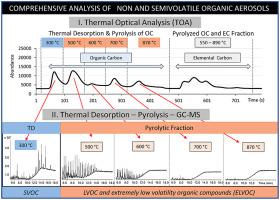当前位置:
X-MOL 学术
›
Atmos. Environ.
›
论文详情
Our official English website, www.x-mol.net, welcomes your
feedback! (Note: you will need to create a separate account there.)
Occurrence of both nonvolatile and semivolatile carbonaceous air particulate markers using thermal desorption-pyrolysis-gas chromatography-mass spectrometry
Atmospheric Environment ( IF 4.2 ) Pub Date : 2021-02-01 , DOI: 10.1016/j.atmosenv.2020.118058 Brett Nespor , Richard Cochran , Haewoo Jeong , Frank Bowman , David Delene , Evguenii Kozliak , Alena Kubátová
Atmospheric Environment ( IF 4.2 ) Pub Date : 2021-02-01 , DOI: 10.1016/j.atmosenv.2020.118058 Brett Nespor , Richard Cochran , Haewoo Jeong , Frank Bowman , David Delene , Evguenii Kozliak , Alena Kubátová

|
Abstract Particulate matter (PM) occurring in the atmosphere is a complex mix of organic species that originate from many sources due to long range transport. Many anthropogenic and biogenic sources have unique chemical components that enable their use as atmospheric markers of emissions. Application of thermal desorption–pyrolysis coupled with gas chromatography-mass spectrometry (TD-Pyr-GC-MS) enabled the characterization of both semivolatile and nonvolatile atmospheric markers in PM, both of which are difficult to characterize using traditional TD or solvent extraction alone. The nonvolatile organic PM fraction was found to be significant based on thermal optical analysis (TOA) quantification, with 73–87% of organic carbon (OC) evolving at temperatures above 400 °C (i.e., Pyr). The semivolatile organic carbon (SVOC) fraction (i.e., TD) of PM featured distinct profiles of alkanes, fatty acids, fatty acid methyl esters and 2-ring polycyclic aromatic hydrocarbons (PAHs), mostly associated with biogenic origin. By contrast, in the Pyr fractions of carbonaceous PM, highly abundant homologous series of n-alkenes, n-alkylbenzenes, PAHs, n-alkanes, and substituted phenols were identified. The occurrence of these compounds is conveyed through newly developed pyrolytic indicators reflecting the breakdown of biogenic sources, e.g., plant lipids, although certain sampling periods showed a contribution of anthropogenic origin. These previously unresolved biogenic and anthropogenic Pyr profiles provide a more representative characterization of atmospheric PM that can help in identifying emission sources.
中文翻译:

使用热解吸-热解-气相色谱-质谱法测定非挥发性和半挥发性碳质空气颗粒标记物
摘要 大气中的颗粒物 (PM) 是一种复杂的有机物种混合物,由于长距离传输,其来源众多。许多人为和生物源具有独特的化学成分,可以用作大气排放标志。热解吸-热解与气相色谱-质谱联用 (TD-Pyr-GC-MS) 的应用能够表征 PM 中的半挥发性和非挥发性大气标志物,这两者都难以单独使用传统的 TD 或溶剂萃取进行表征。根据热光学分析 (TOA) 量化,发现非挥发性有机 PM 部分很重要,73-87% 的有机碳 (OC) 在 400 °C 以上的温度下释放(即 Pyr)。半挥发性有机碳 (SVOC) 部分(即,PM 的 TD) 具有烷烃、脂肪酸、脂肪酸甲酯和 2 环多环芳烃 (PAH) 的独特特征,主要与生物起源有关。相比之下,在碳质 PM 的 Pyr 馏分中,鉴定了非常丰富的正烯烃、正烷基苯、多环芳烃、正烷烃和取代酚的同源系列。这些化合物的出现是通过新开发的热解指标传达的,这些指标反映了生物源(例如植物脂质)的分解,尽管某些采样周期显示出人为来源的贡献。这些以前未解决的生物和人为 Pyr 剖面提供了更具代表性的大气 PM 特征,有助于确定排放源。脂肪酸甲酯和 2 环多环芳烃 (PAH),主要与生物来源有关。相比之下,在碳质 PM 的 Pyr 馏分中,鉴定了非常丰富的正烯烃、正烷基苯、多环芳烃、正烷烃和取代酚的同源系列。这些化合物的出现是通过新开发的热解指标传达的,这些指标反映了生物源(例如植物脂质)的分解,尽管某些采样周期显示出人为来源的贡献。这些以前未解决的生物和人为 Pyr 剖面提供了更具代表性的大气 PM 特征,有助于确定排放源。脂肪酸甲酯和 2 环多环芳烃 (PAH),主要与生物来源有关。相比之下,在碳质 PM 的 Pyr 馏分中,鉴定了非常丰富的正烯烃、正烷基苯、多环芳烃、正烷烃和取代酚的同源系列。这些化合物的出现是通过新开发的热解指标传达的,这些指标反映了生物源(例如植物脂质)的分解,尽管某些采样周期显示了人为来源的贡献。这些以前未解决的生物和人为 Pyr 剖面提供了更具代表性的大气 PM 特征,有助于确定排放源。鉴定了高度丰富的正烯烃、正烷基苯、多环芳烃、正烷烃和取代酚的同源系列。这些化合物的出现是通过新开发的热解指标传达的,这些指标反映了生物源(例如植物脂质)的分解,尽管某些采样周期显示了人为来源的贡献。这些以前未解决的生物和人为 Pyr 剖面提供了更具代表性的大气 PM 特征,有助于确定排放源。鉴定了高度丰富的正烯烃、正烷基苯、多环芳烃、正烷烃和取代酚的同源系列。这些化合物的出现是通过新开发的热解指标传达的,这些指标反映了生物源(例如植物脂质)的分解,尽管某些采样周期显示了人为来源的贡献。这些以前未解决的生物和人为 Pyr 剖面提供了更具代表性的大气 PM 特征,有助于确定排放源。尽管某些采样周期显示出人为原因的贡献。这些以前未解决的生物和人为 Pyr 剖面提供了更具代表性的大气 PM 特征,有助于确定排放源。尽管某些采样周期显示出人为原因的贡献。这些以前未解决的生物和人为 Pyr 剖面提供了更具代表性的大气 PM 特征,有助于确定排放源。
更新日期:2021-02-01
中文翻译:

使用热解吸-热解-气相色谱-质谱法测定非挥发性和半挥发性碳质空气颗粒标记物
摘要 大气中的颗粒物 (PM) 是一种复杂的有机物种混合物,由于长距离传输,其来源众多。许多人为和生物源具有独特的化学成分,可以用作大气排放标志。热解吸-热解与气相色谱-质谱联用 (TD-Pyr-GC-MS) 的应用能够表征 PM 中的半挥发性和非挥发性大气标志物,这两者都难以单独使用传统的 TD 或溶剂萃取进行表征。根据热光学分析 (TOA) 量化,发现非挥发性有机 PM 部分很重要,73-87% 的有机碳 (OC) 在 400 °C 以上的温度下释放(即 Pyr)。半挥发性有机碳 (SVOC) 部分(即,PM 的 TD) 具有烷烃、脂肪酸、脂肪酸甲酯和 2 环多环芳烃 (PAH) 的独特特征,主要与生物起源有关。相比之下,在碳质 PM 的 Pyr 馏分中,鉴定了非常丰富的正烯烃、正烷基苯、多环芳烃、正烷烃和取代酚的同源系列。这些化合物的出现是通过新开发的热解指标传达的,这些指标反映了生物源(例如植物脂质)的分解,尽管某些采样周期显示出人为来源的贡献。这些以前未解决的生物和人为 Pyr 剖面提供了更具代表性的大气 PM 特征,有助于确定排放源。脂肪酸甲酯和 2 环多环芳烃 (PAH),主要与生物来源有关。相比之下,在碳质 PM 的 Pyr 馏分中,鉴定了非常丰富的正烯烃、正烷基苯、多环芳烃、正烷烃和取代酚的同源系列。这些化合物的出现是通过新开发的热解指标传达的,这些指标反映了生物源(例如植物脂质)的分解,尽管某些采样周期显示出人为来源的贡献。这些以前未解决的生物和人为 Pyr 剖面提供了更具代表性的大气 PM 特征,有助于确定排放源。脂肪酸甲酯和 2 环多环芳烃 (PAH),主要与生物来源有关。相比之下,在碳质 PM 的 Pyr 馏分中,鉴定了非常丰富的正烯烃、正烷基苯、多环芳烃、正烷烃和取代酚的同源系列。这些化合物的出现是通过新开发的热解指标传达的,这些指标反映了生物源(例如植物脂质)的分解,尽管某些采样周期显示了人为来源的贡献。这些以前未解决的生物和人为 Pyr 剖面提供了更具代表性的大气 PM 特征,有助于确定排放源。鉴定了高度丰富的正烯烃、正烷基苯、多环芳烃、正烷烃和取代酚的同源系列。这些化合物的出现是通过新开发的热解指标传达的,这些指标反映了生物源(例如植物脂质)的分解,尽管某些采样周期显示了人为来源的贡献。这些以前未解决的生物和人为 Pyr 剖面提供了更具代表性的大气 PM 特征,有助于确定排放源。鉴定了高度丰富的正烯烃、正烷基苯、多环芳烃、正烷烃和取代酚的同源系列。这些化合物的出现是通过新开发的热解指标传达的,这些指标反映了生物源(例如植物脂质)的分解,尽管某些采样周期显示了人为来源的贡献。这些以前未解决的生物和人为 Pyr 剖面提供了更具代表性的大气 PM 特征,有助于确定排放源。尽管某些采样周期显示出人为原因的贡献。这些以前未解决的生物和人为 Pyr 剖面提供了更具代表性的大气 PM 特征,有助于确定排放源。尽管某些采样周期显示出人为原因的贡献。这些以前未解决的生物和人为 Pyr 剖面提供了更具代表性的大气 PM 特征,有助于确定排放源。









































 京公网安备 11010802027423号
京公网安备 11010802027423号